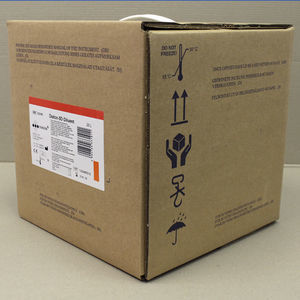
- Laboratory
- Laboratory medicine
- Enzyme reagent
- Diagon Ltd.

- Products
- Catalogs
- News & Trends
- Exhibitions
Enzyme reagent Perox Dil. 3staindiagnosticblood sample
Add to favorites
Compare this product
Characteristics
- Type
- enzyme, stain
- Applications
- diagnostic, blood sample, for hematology
- Tested parameter
- hydrogen peroxide
Description
Perox Dil. 3 is used by Technicon H*1, H*2, H*3 hematological analyzer as a whole blood sample DILUTING reagent.
SUMMARY AND PRINCIPLE
The peroxidase cytochemical reaction consists of 2 steps. In the first step, EDTA anticoagulated whole-blood sample is diluted with Perox Dil. 1 reagent. Surfactants and thermal stress cause lysis of the red blood cells. An aldehyde in Perox Dil.1 reagent fixes the white blood cells. During the second step, Perox Dil. 2 reagent and Perox Dil. 3 reagent are added to the peroxidase reaction chamber. A peroxidase enzyme substrate in Perox Dil. 2 reagent and the hydrogen peroxide in Perox Dil. 3 reagent stain the sites of peroxidase activity in the granules of neutrophils, eosinophils, and monocytes. Lymphocytes, basophils, and large unstained cells contain no granules with peroxidase enzyme activity. A constant volume of the cell suspension from the Perox reaction chamber passes through the flowcell along with Perox Sheath. The two fluids flow as independent, concentric streams (no mixing), with the Perox Sheath stream encasing the sample stream.
Catalogs
No catalogs are available for this product.
See all of Diagon Ltd.‘s catalogsExhibitions
Meet this supplier at the following exhibition(s):

Related Searches
- Solution reagent kit
- Protein reagent kit
- Diagnostic reagent kit
- Laboratory reagent kit
- Enzyme reagent kit
- Reagent medium reagent kit
- Cytology reagent kit
- Dye reagent
- Blood sample reagent kit
- Staining solution reagent kit
- POC reader
- Enzymatic reagent kit
- Hematology reagent kit
- Blood POC reader
- POC reader with touchscreen
- Portable POC reader
- Whole blood POC reader
- Hemoglobin reagent kit
- Laboratory POC reader
- Cleaning reagent kit
*Prices are pre-tax. They exclude delivery charges and customs duties and do not include additional charges for installation or activation options. Prices are indicative only and may vary by country, with changes to the cost of raw materials and exchange rates.






























